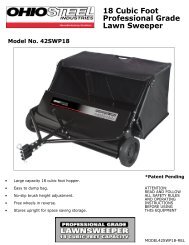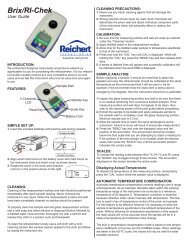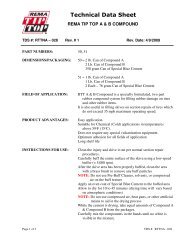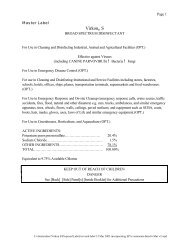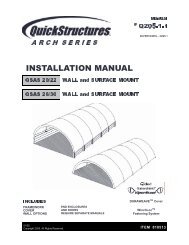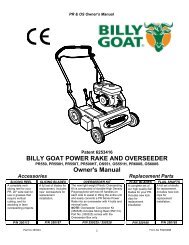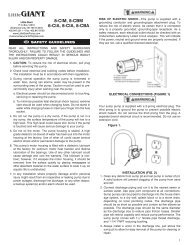CAULIFLOWER: IPM Checklist
CAULIFLOWER: IPM Checklist
CAULIFLOWER: IPM Checklist
Create successful ePaper yourself
Turn your PDF publications into a flip-book with our unique Google optimized e-Paper software.
<strong>CAULIFLOWER</strong>: <strong>IPM</strong> <strong>Checklist</strong><br />
Editor’s Note:How much progress can you make toward full<br />
implementation of <strong>IPM</strong> in your operation? This checklist suggests<br />
<strong>IPM</strong> practices you might apply.To use the checklist,give yourself<br />
full or partial credit for each practice you complete by writing in a<br />
point score for each,then tallying your total.Compare your score<br />
to the maximum potential points listed in the first column.How<br />
does this year’s total compare to last year? Which practices will<br />
you implement next year? Use the blank lines to describe <strong>IPM</strong><br />
practices you develop,or those specific to your region.<br />
Cultural Practices<br />
Maximum<br />
Potential<br />
Points<br />
Actual<br />
Points<br />
Earned<br />
For seedbeds:<br />
Rotate and isolate seedbeds from production<br />
areas to reduce incidence and spread of<br />
diseases such as Alternaria leaf spot,black<br />
rot,blackleg,downy mildew,root rot,and<br />
clubroot diseases. 10 ________<br />
Lime seedbeds to pH 7.2 to 7.5 for<br />
clubroot control (where present). 5 ________<br />
Scout for black rot (where present) and<br />
destroy any black rot-infested beds. 10 ________<br />
Strive for weed-free beds to ensure weeds<br />
do not interfere with transplant<br />
operations. 10 ________<br />
For fields:<br />
Do not plant into fields with a history<br />
of Fusarium yellows or widespread<br />
clubroot. 10 ________<br />
Adjust (spot treat with lime) pH to between<br />
7.2 and 7.5 in spots where clubroot was<br />
noted in previous crops. 10 ________<br />
Plant cauliflower where crucifers were not<br />
grown for at least three years to reduce<br />
Alternaria leaf spot,black rot,downy<br />
mildew,root rot,Sclerotinia white mold,<br />
sugar cauliflower cyst nematode (four<br />
years for blackleg;seven years for<br />
clubroot,Fusarium yellows). 20 ________<br />
For seedbeds and fields:<br />
Test soil at least once every three years.<br />
Maintain records.Fertilize according<br />
to test results. 10 ________<br />
Do not apply animal manure after planting.<br />
Make sure all preplant applications of<br />
manure are properly incorporated into<br />
the soil before planting. 20 ________<br />
Apply any fertilizer/manure according<br />
to a Farm Nutrition Plan. 20 ________<br />
COLUMNTOTAL<br />
________<br />
Maximum Actual<br />
Potential Points<br />
Points Earned<br />
Use certified,hot-water treated seed to<br />
reduce Alternaria leaf spot,black rot,<br />
blackleg or use seed tests to determine<br />
if seed is infected. 20 ________<br />
Use insecticide application for cabbage<br />
maggot control only when fields are at<br />
risk from peak adult flights. 20 ________<br />
Inspect all transplants and use only if free<br />
of diamondback moth,black rot,blackleg,<br />
clubroot and Alternarialeaf spot. 20 ________<br />
After harvest in early and mid-season<br />
fields,disk/plow cauliflower residues to<br />
promote breakdown of tissues infected<br />
with black rot,Alternaria leaf spot,<br />
blackleg,clubroot,downy mildew,root<br />
rot and Sclerotinia white mold. 10 ________<br />
After harvest,establish a cover crop for<br />
weed control,nitrogen retention for early<br />
and mid-season fields. 10 ________<br />
After harvest for late season plantings,<br />
interseed a cover crop at last cultivation. 10 ________<br />
Pesticide Management<br />
Approved and registered pesticides are<br />
used according to label.Application records,<br />
including date,location,applicator,target<br />
pest,pesticide name,EPA registration<br />
number,formulation,rate and number<br />
of acres treated are maintained. 10 ________<br />
Insecticide/fungicide sprayer is calibrated<br />
at least once a year. 10 ________<br />
Herbicide sprayer is calibrated at least<br />
once a year. 10 ________<br />
Drift is minimized. 10 ________<br />
Among pesticides of comparable efficacy,<br />
the one with the least risks to farmworker<br />
safety,natural enemies and the<br />
environment is selected. 10 ________<br />
Pesticides are applied using techniques to<br />
provide good coverage.At least once per<br />
season,sprayer coverage is tested using<br />
water-sensitive paper. 10 ________<br />
If pesticides do not appear to be effective,<br />
contact Cooperative Extension Service to<br />
check for resistance to pesticides. 10 ________<br />
COLUMNTOTAL<br />
________<br />
(Continued)
<strong>CAULIFLOWER</strong>: <strong>IPM</strong> <strong>Checklist</strong> (CONTINUED)<br />
Maximum Actual<br />
Potential Points<br />
Points Earned<br />
Disease Pest Management<br />
Scout weekly for diseases.For black rot,<br />
downy mildew,Alternaria leaf spot,Fusarium<br />
yellows,and Sclerotinia white mold. Use<br />
recommended scouting techniques.For<br />
cabbage maggot,clubroot,root rot and<br />
sugar cauliflower cyst nematode,<br />
note presence. 20 ________<br />
If black rot occurs in field,do not cultivate<br />
or spray until foliage is dry.Clean equipment<br />
after use in infected fields. 20 ________<br />
If Alternariais found to be present,try to<br />
tie plants late and harvest earlier to avoid<br />
infection spread. 20 ________<br />
Insect Pest Management<br />
Follow established thresholds for insect<br />
pests whenever available. 20 ________<br />
Scout weekly for insect pests:cabbage looper,<br />
diamondback moth,imported cabbageworm<br />
and cabbage aphids.Use recommended<br />
scouting techniques.Scout one to three<br />
times per week for flea beetles when plants<br />
are in seedling stage.For cabbage maggot<br />
and sugar cauliflower cyst nematode,note<br />
presence or absence. 20 ________<br />
If flea beetles or aphids are not at or<br />
above thresholds,use Bacillus thuringiensis<br />
materials for caterpillar control. 10 ________<br />
Keep records of pest densities,biological<br />
control techniques used,cultural procedures,<br />
and pesticide applications.Keep records of<br />
pest populations for each field for review<br />
in future years.Keep records of natural<br />
enemy populations. 20 ________<br />
Weed Pest Management<br />
Make a weed map post-harvest to evaluate<br />
effectiveness of weed control strategies.<br />
Review weed maps of fields to choose<br />
appropriate weed control strategies the<br />
following season. 20 ________<br />
Weather and Crop Monitoring<br />
Weather and crop parameters are monitored<br />
and recorded daily.<br />
Min/max temperatures 20 ________<br />
Rainfall 20 ________<br />
Hours of leaf wetness 20 ________<br />
Stage of plant development<br />
(by cultivar weekly) 20 ________<br />
COLUMNTOTAL<br />
________<br />
Maximum Actual<br />
Potential Points<br />
Points Earned<br />
Education<br />
Reference library of one or more books on<br />
cauliflower management is maintained.(List books.)<br />
#1._________________________________ 10 ________<br />
#2._________________________________ 10 ________<br />
#3._________________________________ 10 ________<br />
Grower attends one or more Cooperative<br />
Extension-approved workshops during<br />
the year.<br />
#1._________________________________ 10 ________<br />
#2._________________________________ 10 ________<br />
#3._________________________________ 10 ________<br />
Grower is a member of one or more<br />
grower associations.<br />
#1._________________________________ 10 ________<br />
#2._________________________________ 10 ________<br />
#3._________________________________ 10 ________<br />
Grower subscribes to one or more Cooperative<br />
Extension or industry trade publications.<br />
#1._________________________________ 10 ________<br />
#2._________________________________ 10 ________<br />
#3._________________________________ 10 ________<br />
Grower maintains a library of one or more<br />
titles on pest management.<br />
#1._________________________________ 10 ________<br />
#2._________________________________ 10 ________<br />
#3._________________________________ 10 ________<br />
Additional Practices<br />
Fieldworker sanitation practices are<br />
instituted (i.e.,wash hands before<br />
harvesting/handling crop). 10 ________<br />
#2._________________________________ 10 ________<br />
#3._________________________________ 10 ________<br />
#4._________________________________ 10 ________<br />
COLUMNTOTAL<br />
<strong>CAULIFLOWER</strong>:GRANDTOTAL<br />
________<br />
________<br />
Acknowledgment:This <strong>IPM</strong> <strong>Checklist</strong> for Cauliflower is adapted<br />
from the New York State Integrated Pest Management Elements for<br />
Cauliflower,by Curt Petzoldt,vegetable <strong>IPM</strong> coordinator,with<br />
input from Cornell research scientists,Cooperative Extension<br />
educators,and cauliflower growers and processors.



